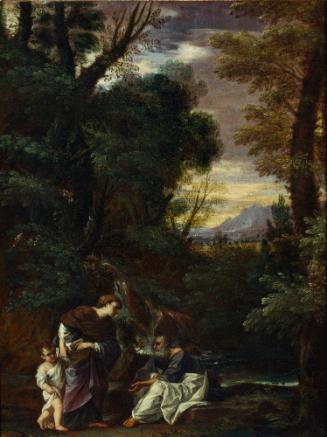The Prophet Elijah and the Widow of Zaraphath
Artist
Pier Francesco Mola
(Italian, 1612-1666)
Dateca. 1650
CultureItalian
MediumOil on canvas
ClassificationPaintings
ProvenanceBy 1790, George Aufrère (1715–1801), London; from 1801 and until 1804, his widow, Mrs. George (née Arabella Bate) Aufrère, London; from 1804 until 1823, her son-in-law, Charles Anderson-Pelham (1749–1823), 1st Baron Yarborough, Brocklesby Park, Lincolnshire; by inheritance to his son, Charles Anderson-Pelham (1781–1846), 1st Earl of Yarborough, Brocklesby Park, Lincolnshire; by inheritance to his son, Charles Anderson Worsley Anderson-Pelham (1809–1862), 2nd Earl of Yarborough, Brocklesby Park, Lincolnshire; by inheritance to his son, Charles Anderson- Pelham (1835–1875), 3rd Earl of Yarborough, Brocklesby Park, Lincolnshire; by inheritance to his son, Charles Alfred Worsley Pelham (1859–1936), 4th Earl of Yarborough, Brocklesby Park, Lincolnshire; (sold Yarborough sale, Christie’s, London, 12 July 1929, lots 53 and 52, for £73–10s); (Arthur U. Newton, New York); John Ringling (1866–1936), Sarasota, Florida; bequest in 1936 to the John and Mable Ringling Museum of Art, Sarasota, Florida.
Credit LineBequest of John Ringling, 1936
Object numberSN138
This picture, along with 'The Prophet Elisha and the Rich Woman of Shunem,' was likely commissioned for the church of San Martino ai Monti in Milan. According to the Old Testament Book of Kings, Elijah asked a woman to give him her remaining food during a famine. Because she did so, Elijah ensured that she and her family were miraculously fed by a never-empty jar of flour and flask of oil. Though technically a narrative, the painting explored the expressive nature of landscape and light, and betrays a response to Venetian painting.
On View
On viewLocation
DimensionsImage: 25 3/4 x 19 1/4 in. (65.4 x 48.9 cm)- Museum of Art, Gallery 07
Frame: 33 1/4 × 27 in. (84.5 × 68.6 cm)













